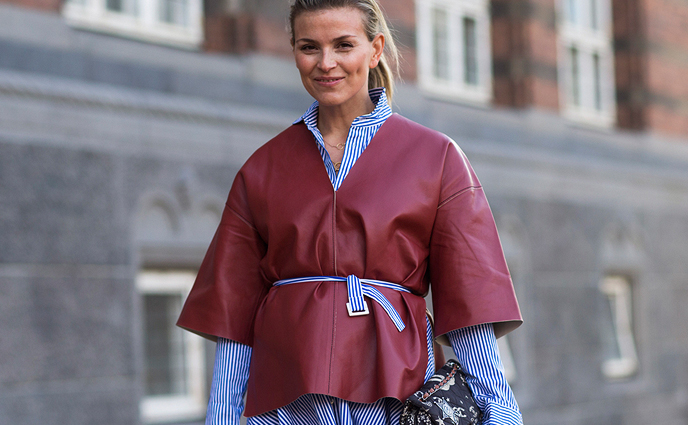Another hard truth about pregnancy: Even if you make it through your first -- or even second -- trimester unscathed by acne, other skin woes may threaten to snatch your pregnancy glow. Though my pregnancy acne sorrows mostly subsided by 17 or 18 weeks (thanks in part to hormones and in part to a healthy regimen of glycolic acid cleansing, I suspect), I noticed two small, faint splotches of discoloration blooming on my cheeks at around 26 weeks (so yeah, still not glowing).
Melasma, or pregnancy mask, is another issue that seems to disproportionately plague expectant moms. It's a form of hyperpigmentation that looks like light or dark brown patches on your face. "About 50 pregnant of pregnant women have some form of melasma. Some people get a few spots, for others it's severe," Sullivan says. In other words, it can range from small splotches to large swaths covering the face.
Like pregnancy acne, melasma is caused in part by our old pal, pregnancy hormones. "Pigment cells called melanocytes are very active during pregnancy so when they are exposed to sun, they overproduce pigment," says Tanzi. Because the sun also plays a role, this is why you'll see melasma more commonly on the face, as opposed to less exposed parts of your body.
Image via Getty
Melasma, or pregnancy mask, is another issue that seems to disproportionately plague expectant moms. It's a form of hyperpigmentation that looks like light or dark brown patches on your face. "About 50 pregnant of pregnant women have some form of melasma. Some people get a few spots, for others it's severe," Sullivan says. In other words, it can range from small splotches to large swaths covering the face.
Like pregnancy acne, melasma is caused in part by our old pal, pregnancy hormones. "Pigment cells called melanocytes are very active during pregnancy so when they are exposed to sun, they overproduce pigment," says Tanzi. Because the sun also plays a role, this is why you'll see melasma more commonly on the face, as opposed to less exposed parts of your body.
Image via Getty
Though sometimes melasma will disappear on its own, it can be a lot trickier to manage than pregnancy acne. "The melanocytes are finicky and deep in the skin. They don't respond as well to topical treatment. There are few ways to reliably treat melasma," Sullivan says.
Moms-to-be should definitely steer clear of products containing hydroquinone, a common brightening agent. While studies haven't found a correlation between hydroquinone and birth defects, research indicates that the body absorbs around 35 to 45 percent of topical hydroquinone, making it much riskier to use than ingredients that are absorbed at a much lower rate.
Your best bet? Focus on preventing melasma by being exceptionally cautious with sun exposure. "Wear a heavy sunscreen -- the kind that makes your face white -- when you're outdoors," Shamban says. (Though it won't make your face white, I like Isdin Eryfotona Actinica Ultralight Emulsion SPF 50+, $50, for its high SPF and lightweight mineral formula, but here are a bunch of other great mineral sunscreen options).
And think beyond the beauty counter. "The best defense for hyperpigmentation during pregnancy is a hat because even sunscreen will allow melasma to develop," Tanzi adds. "Always wear a hat when in the sun during pregnancy." (We're a fan of these stylish sun hats.)
Additionally, glycolic acid may further cement itself as your skin's new BFF, as it's another safe way to help even out your skin tone during pregnancy. After you've made it through your pregnancy, Sullivan says you can consider more aggressive treatments, like chemical peels and lasers -- one of which I hope to have time to book somewhere between picking out a daycare and sending the little one off to college.
Moms-to-be should definitely steer clear of products containing hydroquinone, a common brightening agent. While studies haven't found a correlation between hydroquinone and birth defects, research indicates that the body absorbs around 35 to 45 percent of topical hydroquinone, making it much riskier to use than ingredients that are absorbed at a much lower rate.
Your best bet? Focus on preventing melasma by being exceptionally cautious with sun exposure. "Wear a heavy sunscreen -- the kind that makes your face white -- when you're outdoors," Shamban says. (Though it won't make your face white, I like Isdin Eryfotona Actinica Ultralight Emulsion SPF 50+, $50, for its high SPF and lightweight mineral formula, but here are a bunch of other great mineral sunscreen options).
And think beyond the beauty counter. "The best defense for hyperpigmentation during pregnancy is a hat because even sunscreen will allow melasma to develop," Tanzi adds. "Always wear a hat when in the sun during pregnancy." (We're a fan of these stylish sun hats.)
Additionally, glycolic acid may further cement itself as your skin's new BFF, as it's another safe way to help even out your skin tone during pregnancy. After you've made it through your pregnancy, Sullivan says you can consider more aggressive treatments, like chemical peels and lasers -- one of which I hope to have time to book somewhere between picking out a daycare and sending the little one off to college.





